Aniline leather offers a natural, breathable surface with minimal pigmentation, highlighting the leather's authentic texture and softness for premium car seats. Pigmented leather features a durable, uniform coating that resists stains and UV damage, making it ideal for high-traffic automotive interiors.
Table of Comparison
| Feature | Aniline Leather | Pigmented Leather |
|---|---|---|
| Finish | Natural, soft, porous | Opaque, coated, uniform |
| Appearance | Shows natural markings and grain | Consistent color, hides imperfections |
| Durability | Less resistant to stains and UV | Highly resistant to stains, UV, and scratches |
| Comfort | Breathable and soft | Less breathable due to coating |
| Maintenance | Requires careful cleaning and conditioning | Easy to clean and maintain |
| Cost | Higher price due to premium quality | More affordable with broader availability |
| Usage | Luxury, high-end car seats | Mass-market and commercial vehicles |
Introduction: Understanding Aniline and Pigmented Leather
Aniline leather is a natural, transparent finish leather that retains the hide's original texture and markings, offering a soft, breathable, and luxurious feel ideal for premium car seats. Pigmented leather, coated with a durable pigmented layer, provides enhanced resistance to stains, fading, and wear, making it a practical choice for high-traffic automotive interiors. Understanding these distinct finishes helps in selecting the right leather type based on comfort preferences and durability requirements for car seating.
Key Differences Between Aniline and Pigmented Leather
Aniline leather offers a natural, soft feel with visible grain and unique markings due to its minimal surface coating, enhancing breathability and aging gracefully in car seats. Pigmented leather, coated with a durable pigment layer, provides superior resistance to stains, UV rays, and wear, making it easier to maintain but less breathable and less prone to natural patina development. Key differences include aniline's premium appearance and vulnerability to damage versus pigmented leather's robust protection and uniform color retention in automotive seating.
Appearance and Texture: Natural Look vs Uniform Finish
Aniline leather for car seats offers a natural look with visible pores and unique markings, highlighting the leather's organic characteristics and providing a soft, supple texture that enhances comfort. Pigmented leather features a uniform finish due to a protective colored coating that conceals imperfections, resulting in a smoother, more consistent surface ideal for durability and easy maintenance. The choice between aniline and pigmented leather balances aesthetic preferences for natural authenticity versus practical uniformity in appearance and texture.
Comfort and Feel: Softness and Breathability Compared
Aniline leather offers superior softness and natural breathability due to its minimal surface coating, allowing the leather to retain its natural texture and enhance comfort in car seats. Pigmented leather, coated with a protective layer, provides a more uniform appearance but tends to be less breathable and slightly firmer to the touch, which can reduce overall seating comfort. Choosing aniline leather prioritizes a plush, breathable feel ideal for luxury vehicles, whereas pigmented leather emphasizes durability and ease of maintenance.
Durability and Wear Resistance in Car Seats
Aniline leather, prized for its natural look and suppleness, offers a luxurious feel but has lower durability and wear resistance compared to pigmented leather, making it more susceptible to stains and fading in car seats. Pigmented leather features a surface coating that enhances its resistance to scratches, UV damage, and abrasion, providing superior longevity in high-use automotive interiors. For car seats exposed to frequent contact and environmental stress, pigmented leather ensures better maintenance of appearance and structural integrity over time.
Maintenance and Cleaning Requirements
Aniline leather for car seats requires gentle maintenance with pH-balanced cleaners and regular conditioning to prevent stains and fading due to its porous surface. Pigmented leather offers superior resistance to spills and dirt because of its durable surface coating, allowing for easier cleaning with mild soap and water without risk of color loss. Choosing pigmented leather reduces long-term upkeep efforts, while aniline leather demands more attentive care to preserve its natural appearance.
Stain Resistance and Spill Protection
Aniline leather offers a natural, porous surface that absorbs spills quickly, making it more susceptible to stains and requiring careful maintenance for car seats. Pigmented leather features a durable, protective topcoat that provides superior stain resistance and spill protection, ideal for high-traffic automotive interiors. Choosing pigmented leather ensures easier cleaning and prolonged seat aesthetics, especially in vehicles exposed to frequent dirt and liquids.
Cost Comparison: Aniline vs Pigmented Leather
Aniline leather for car seats typically costs significantly more than pigmented leather due to its natural dyeing process and minimal protective coatings, which preserve the hide's natural texture but require more careful handling. Pigmented leather, coated with a durable polymer layer, is less expensive and more resistant to stains and wear, making it a cost-effective choice for budget-conscious buyers. The higher price of aniline leather reflects its premium quality and aesthetic appeal, while pigmented leather balances affordability with enhanced durability.
Suitability for Different Car Owners and Usage
Aniline leather, known for its natural softness and breathability, suits luxury car owners who prioritize comfort and aesthetic appeal, though it requires careful maintenance to prevent stains and fading. Pigmented leather, coated with a durable pigment layer, is ideal for families or daily drivers seeking high resistance to wear, scratches, and UV exposure, offering easier cleaning and longer-lasting appearance. Choosing between aniline and pigmented leather depends on the owner's lifestyle, maintenance willingness, and preference for either a natural look or enhanced durability.
Conclusion: Choosing the Best Leather for Your Car Seats
Aniline leather offers a natural, soft feel with breathable qualities, enhancing comfort but requires careful maintenance due to its susceptibility to stains and fading. Pigmented leather provides superior durability and ease of cleaning, making it ideal for high-traffic car seats and families. Selecting between aniline and pigmented leather depends on balancing the importance of luxury and aesthetics versus longevity and practicality for your specific car seat needs.

Infographic: Aniline leather vs Pigmented leather for Car seat
 azmater.com
azmater.com